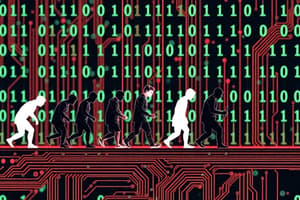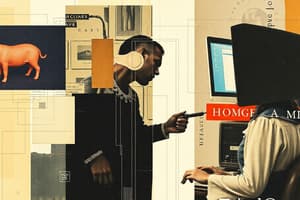Podcast
Questions and Answers
What is the primary function of the Central Processing Unit (CPU)?
What is the primary function of the Central Processing Unit (CPU)?
- Storage of data
- Perform arithmetic and logic operations (correct)
- Input of data
- Output of information
What is the backbone of a computer?
What is the backbone of a computer?
Motherboard
The first microprocessor was invented by Intel.
The first microprocessor was invented by Intel.
True (A)
Which of the following is NOT an input device?
Which of the following is NOT an input device?
The first general-purpose computer developed was the ________.
The first general-purpose computer developed was the ________.
Which generation of computers used vacuum tubes?
Which generation of computers used vacuum tubes?
Who is known as the father of computers?
Who is known as the father of computers?
The Integrated Circuit (IC) was smaller and more reliable than transistors.
The Integrated Circuit (IC) was smaller and more reliable than transistors.
What term refers to devices that allow data and instructions to be entered into a computer?
What term refers to devices that allow data and instructions to be entered into a computer?
What is the primary purpose of software in a computer system?
What is the primary purpose of software in a computer system?
Flashcards are hidden until you start studying
Study Notes
Course Overview
- Course: CIT 0513 - Computer & Programming
- Lecturer: Ms. Hapizah Mohd Hanapi, Senior Technical Training Officer in Industrial Automation & Control
- Email Contact: [email protected]
Course Topics
- Evolution of Computers
- Computer Hardware and Components
- Computer Software, including Operating Systems
- Introduction to Office Packages
- Understanding Computer Viruses
Course Assessment Structure
- Theory Tests: 20% (10% for each of two tests)
- Final Project: 30%
- Project-Based Learning (PBL): 50% total (15% for PBL #1, 10% for PBL #2, 15% for PBL #3, 10% KIS)
Information Technology Overview
- Use of technology for information management: capture, storage, retrieval, analysis, and communication.
- Key sectors impacted by IT: Education, Government, Communication, Finance, Manufacturing, Health, Publishing, Travel.
Importance of Computers
- Essential in modern life as communication tools and infrastructure components.
- Integral to various household and mobile appliances.
Historical Development of Computers
- Early methods of data representation utilized physical objects.
- Charles Babbage developed the Analytical Engine in the 1830s, laying the groundwork for modern computing.
- Ada Lovelace recognized for creating instructions for the Analytical Engine, considered the first computer programmer.
- Herman Hollerith introduced a tabulating machine for the 1890 US census, leading to the founding of IBM.
Milestones in Computer History
- 1940s: Development of the Atanasoff-Berry Computer (ABC), the first electronic digital computer.
- 1951: Introduction of UNIVAC I, the first computer designed for business.
- Transition from vacuum tubes to transistors (Second Generation), improving reliability and size.
- Integration of circuits into chips (Third Generation), allowing for sophisticated software applications.
- The invention of the microprocessor (Fourth Generation) expanded the capabilities and accessibility of computers.
- Fifth Generation focused on Artificial Intelligence, with major developments in personal computing starting in the 1980s.
Basic Components of a Computer System
- Computer systems consist of four main functions: Input, Process, Output, and Storage.
- Essential components include input devices, system unit (with the motherboard and CPU), output devices, and secondary storage devices.
Input/Output Devices
- I/O devices handle communication between the computer and external entities.
- Input devices capture data for processing, while output devices convey information to users.
System Unit Details
- Contains electronic circuits for processing data.
- The motherboard connects all components, including the processor and memory.
Secondary Storage Devices
- Also known as auxiliary storage, these devices retain data and instructions when not in active use.
- Examples: Hard disk drives, floppy disks, and other forms of external storage.
Central Processing Unit (CPU)
- The CPU is the core component responsible for executing instructions, performing calculations, and managing data.
- Comprised of two main units:
- Control Unit: fetches and decodes instructions, executes tasks.
- Arithmetic Logic Unit (ALU): performs arithmetic and logic operations.
Studying That Suits You
Use AI to generate personalized quizzes and flashcards to suit your learning preferences.




